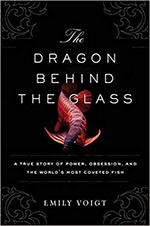 A whole book about aquarium fish? Yes, it’s possible, when the fish is the Asian arowana. The subtitle of Emily Voigt’s The Dragon Behind the Glass is “A True Story of Power, Obsession, and the World’s Most Coveted Fish.” The arowana is a fish that can be found in the Amazon (sometimes called the ‘water monkey’ there for its habit of jumping out of the water) but another species can be found in southeast Asia. This variety is green in most places, but golden varieties also exist, and it can be red in the heart of Borneo. These red arowana are seen as a status symbol in some Asian cultures, and an individual adult fish can sell for hundreds of thousands of dollars. The high price has precipitated several impacts. For one, it’s made dealing with the fish a high-stakes operation, with theft and even murder committed to access such a valuable commodity. It’s also depleted wild stocks of the fish, and nurtured a arowana-farming industry, resulting in a situation where the arowana is utterly endangered in the wild, but doing just fine in captivity (though unable to be traded internationally due to CITES regulations). The author, Emily Voigt, learns about the arowana on an endangered species bust in New York, but it leads her down a rabbit hole of learning, conversation, exploration, and obsession. As with The Feather Thief, which I reviewed Monday in this space, the subtitular ‘obsession’ could apply equally to the people Voigt describes, and to Voigt herself as the author. As she learns more, she becomes fixated on seeing an arowana in the wild, and makes multiple trips to Borneo to try and achieve that goal, stymied constantly by logistical matters. Along the way, she befriends a quirky fish-obsessed explorer, and learns of a new variety of arowana (with “batik” patterns on its scales) in an inaccessible jungle river in Myanmar. She tries to get to that one, too, carrying the mantle of scientific inquiry as her goal – seeking a type specimen for an ichthyologist to describe. Finally, she journeys to the Amazon basin, witnessing deforestation and dodging headhunters on her quest for a brief sighting of a wild arowana. I think the parts of the book I found most compelling were Voigt’s descriptions of the expeditions she made, trying tenaciously to access truly wild places, and how they are both simultaneously extraordinarily hard to visit and yet (once there) found to also already carry the heavy mark of humanity’s blighted touch. Combining economics, character studies, a history of the aquarist hobby culture, biology and ecology with a good dose of adventure travel, I found The Dragon Behind the Glass to be an enjoyable read.
A whole book about aquarium fish? Yes, it’s possible, when the fish is the Asian arowana. The subtitle of Emily Voigt’s The Dragon Behind the Glass is “A True Story of Power, Obsession, and the World’s Most Coveted Fish.” The arowana is a fish that can be found in the Amazon (sometimes called the ‘water monkey’ there for its habit of jumping out of the water) but another species can be found in southeast Asia. This variety is green in most places, but golden varieties also exist, and it can be red in the heart of Borneo. These red arowana are seen as a status symbol in some Asian cultures, and an individual adult fish can sell for hundreds of thousands of dollars. The high price has precipitated several impacts. For one, it’s made dealing with the fish a high-stakes operation, with theft and even murder committed to access such a valuable commodity. It’s also depleted wild stocks of the fish, and nurtured a arowana-farming industry, resulting in a situation where the arowana is utterly endangered in the wild, but doing just fine in captivity (though unable to be traded internationally due to CITES regulations). The author, Emily Voigt, learns about the arowana on an endangered species bust in New York, but it leads her down a rabbit hole of learning, conversation, exploration, and obsession. As with The Feather Thief, which I reviewed Monday in this space, the subtitular ‘obsession’ could apply equally to the people Voigt describes, and to Voigt herself as the author. As she learns more, she becomes fixated on seeing an arowana in the wild, and makes multiple trips to Borneo to try and achieve that goal, stymied constantly by logistical matters. Along the way, she befriends a quirky fish-obsessed explorer, and learns of a new variety of arowana (with “batik” patterns on its scales) in an inaccessible jungle river in Myanmar. She tries to get to that one, too, carrying the mantle of scientific inquiry as her goal – seeking a type specimen for an ichthyologist to describe. Finally, she journeys to the Amazon basin, witnessing deforestation and dodging headhunters on her quest for a brief sighting of a wild arowana. I think the parts of the book I found most compelling were Voigt’s descriptions of the expeditions she made, trying tenaciously to access truly wild places, and how they are both simultaneously extraordinarily hard to visit and yet (once there) found to also already carry the heavy mark of humanity’s blighted touch. Combining economics, character studies, a history of the aquarist hobby culture, biology and ecology with a good dose of adventure travel, I found The Dragon Behind the Glass to be an enjoyable read.
